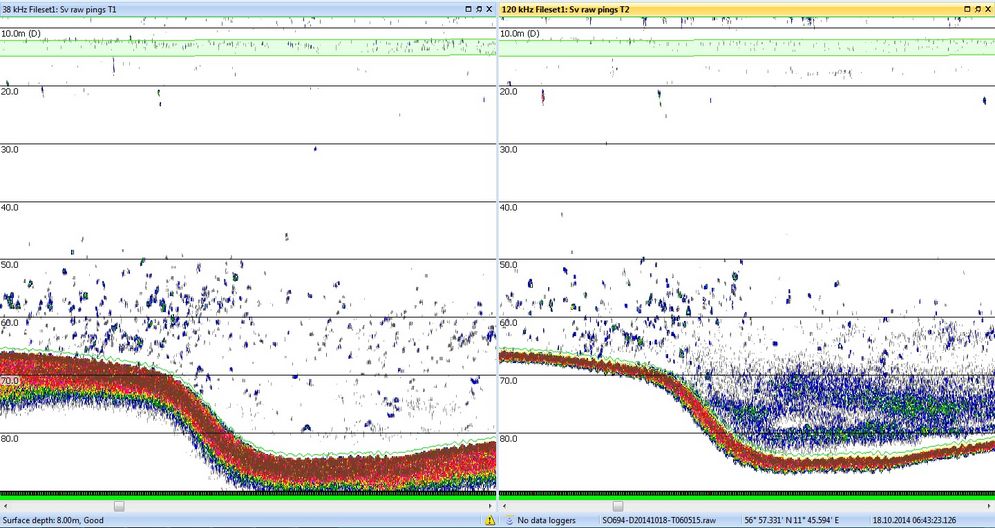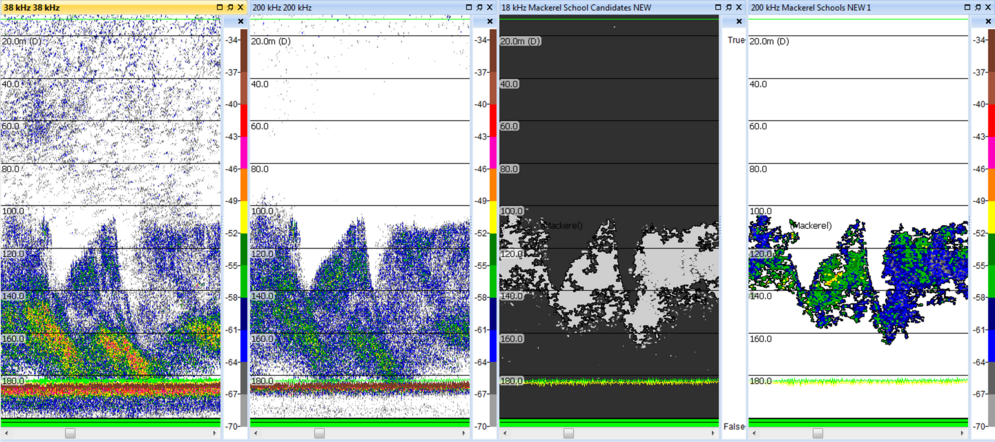Project
Hydroacoustics - Methods, Applications, Development

Adaptation and further development of methods for hydroacoustic estimation of fish stocks
Hydroacoustic methods utilize sound waves to detect marine organisms. Modern echosounders can not only be used to determine stock parameters but also allow identification of habitat use, species composition and further parameters of marine ecosystems.
Background and Objective
Hydroacoustic monitoring methods allow direct determination of stock parameters and distribution patterns of (mainly) pelagic fish species. To utilise these parameters as a basis for predictive models estimating sustainable catch quantitites and to allow conclusions on distribution patterns and habitat use of different fish species, spatially highly resolving surveys of corresponding areas are required. Further, for an implementation of an ecosystem approach, species-specific parameters have to be measured. Therefore, modern acoustic methods can be applied to obtain abundance and distribution estimates for different marine organisms and trophic levels, thus allowing an in-situ assessment of pelagic marine ecosystems.
Target Group
Policy-makers in marine environmental as well as common fisheries policy; Fisheries scientists; interested public
Approach
The project is based on data that are collected during regularly conducted hydroacoustic surveys or on additional data that are collected during other surveys. Together with established post-processing methods for hydroacoustic data, further analyses on acoustic species identification, abiotic environmental parameters as well as acoustic/physical processes are conducted. By comparing multifrequency data from modern scientific echosounders with known acoustic parameters of different marine species, we are able to assess spatially highly resolving distribution patterns and habitat preferences of multiple fish species. Furthermore, we are able to estimate the precision of established trawl surveys in relation to actual distribution patterns of target species. By estimating hydroacoustically based abundance indices, we are able to provide and implement alternative survey concepts for important fish stocks. Additionally, we analyse influences of the physical environment on both distribution patterns as well as scattering/acoustic properties of fishes.
Data and Methods
Hydroacoustic data are collected with modern scientific multifrequency echosounders.
Our Research Questions
- How can hydroacoustic data contribute to an ecosystem survey?
- How can we utilise hydroacoustic data to evaluate and expand established scientific surveys?
Preliminary Results
- Publications in international, peer-reviewed journals
- Presentations and working group documents in different ICES working groups (e.g. WGFAST, WGIPS etc.)
- Improved and simplified survey planning
Researchers from the Thünen Insititute have developed an R package that allows quick and easy planning of transects (https://github.com/SvenGastauer/SurvPlan)
- Target Strength modelling
Researchers from the Thünen Insititute have developed an R package that allows the modelling of the target strength of fish and zooplankton (KRM,DWBA)
Links and Downloads
Thünen-Contact

Involved Thünen-Partners
Duration
1.2001 - 12.2027
More Information
Project status:
ongoing
Fotostrecke (ziehen Sie das Bild zur Seite)


Publications
- 0
Scoulding B, Fairclough DV, Devine C, Jackson G, Lewis P, Waltirck D, West L, Skepper C, Briggs J, Lek E, Yeoh D, Crisafulli BM, Fisher E, Denham A, Mitchell P, Gastauer S (2024) Aerial drones and recreational fish finders: evaluating a low-cost method for surveying fish aggregations. Mar Freshwater Res 75(18):MF24207, DOI:10.1071/MF24207
- 1
Van Dijk TAGP, Roche M, Lurton X, Fezzani R, Simmons SM, Gastauer S, Fietzek P, Mesdag C, Berger L, Klein Breteler M, Parsons DR (2024) Bottom and suspended sediment backscatter measurements in a flume - Towards quantitative bed and water column properties. J Mar Sci Eng 12(4):609, DOI:10.3390/jmse12040609
- 2
Albernhe S, Allain G, Andersen LN, Annasawmy P, Ariza A, Barbin L, Berger L, Blanluet A, Bolser D, Boswell K, Boyra G, Calin A, Calise L, Carlsen A, Carron R, Chawarski J, Cordoba-Sellès P, Cotté C, Gastauer S, Schaber M, et al (2024) ICES WGFAST, IUEM, Plouzané, France, 9-12 April 2024. Copenhagen: ICES, 51 p, ICES Sci Rep
- 3
Lebourges-Dhaussy A, Ariza A, Diogoul N, Gastauer S, Handegard NO, Jech M, Khodabandeloo B, Bouffant N Le, Lee W-J, Macaulay G, Receveur A, Ryan T, Sakinan S, Schaber M, Stevens J, Sullivan P, Viehmann H, Wall C, Warren J, Wieczorek A, Zydlewski G (2023) Working Group of Fisheries Acoustics, Science and Technology (WGFAST). Copenhagen: ICES, iii, 11 p, ICES Sci Rep 5(90), DOI:10.17895/ices.pub.24190512
- 4
Jech M, Schaber M, Gastauer S, Alegria N, Algroy T, Andersen LN, Anderson C, Annasawmy AP, Arendt C, Ariza A, Barbin L, Berger L, Boyra G, Brehmer P, Bristow M, Calise L, Carlsen A, Cermak J, Chawarski J, Chu D, et al (2022) Working Group of Fisheries Acoustics, Science and Technology (WGFAST). Copenhagen: ICES, 93 p, ICES Sci Rep 4(54), DOI:10.17895/ices.pub.20178464
- 5
Jech M, Ariza A, De Robertis A, Rezvanifar A, Lavery AC, Lebourges-Dhaussy A, Sepulveda A, Bertrand A, Blanluet A, Scoulding B, Berges B, Bárðarson B, Robinson C, Wall C, Anderson C, Taylor C, O'Donnel C, Grados D, Copland D, Schaber M, et al (2020) Working Group on Fisheries Acoustics, Science and Technology (WGFAST). Copenhagen: ICES, 18 p, ICES Sci Rep 2(70), DOI:10.17895/ices.pub.7444
- 6
Gröhsler T, Schaber M (2014) Annex 6: Cruise reports from other acoustic surveys in the area : Annex 6a: Western Baltic acoustic survey ; Survey report for FRV "Solea" ; German Acoustic Autumn Survey (GERAS), 30 September 2013 - 19 October 2013. In: Report of the Working Group of International Pelagic Surveys (WGIPS) ; 20-24 January 2014. Copenhagen: ICES, pp 224-251
- 7
Gröhsler T, Schaber M (2014) Survey Report for FRV "Solea" German Acoustic Autumn Survey (GERAS) 30 September 2013 - 19 October 2013. In: Report of the Baltic International Fish Survey Working Group (WGBIFS) : 24-28 March 2014 ; Gdynia, Poland. Copenhagen: ICES, pp 250-258
- 8
Planque B, Kristinsson K, Astakhov A, Bernreuther M, Bethke E, Drevetnyak K, Nedreaas K, Reinert J, Rolskiy A, Sigurdsson T, Stransky C (2013) Monitoring beaked redfish (Sebastes mentella) in the North Atlantic, current challenges and future prospects. Aquatic Liv Res 26(4):293-306, doi:10.1051/alr/2013062
- 9
Schaber M, Gröhsler T (2013) Survey Report for FRV "Solea" 2-21 October 2012. In: Report of the Baltic International Fish Survey Working Group (WGBIFS) : Annex 8: Cruise reports of acoustic surveys BASS and BIAS in 2012. Copenhagen: ICES, pp 266-289

![[Translate to English:] [Translate to English:]](/media/_processed_/7/1/csm_IMG_7977_large_1defaf5de1.jpg)





